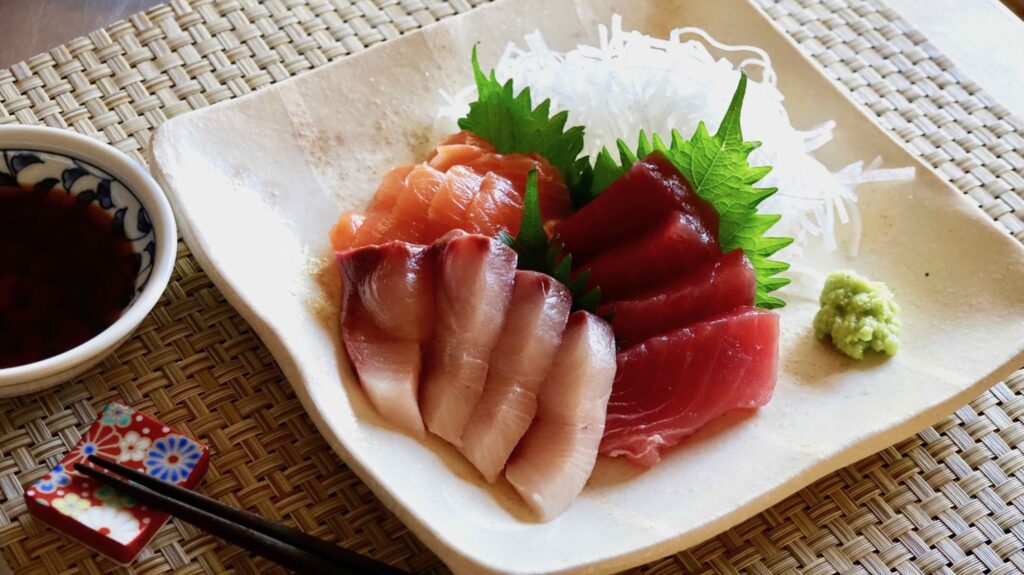
Short Description:
Sashimi is a classic Japanese dish that showcases the pure, delicate flavors of fresh, raw fish. Unlike sushi, sashimi is not served with rice but is often accompanied by garnishes like shredded daikon radish, shiso leaves, and soy sauce. This dish is perfect for seafood lovers who appreciate simplicity and elegance. In this guide, you’ll learn how to make sashimi at home, including a detailed ingredients list, step-by-step instructions, nutrition facts, and tips to ensure your sashimi is both safe and delicious.

Ingredients List
Here’s what you’ll need to make sashimi at home:
- Fresh Fish: 200-300g sushi-grade tuna, salmon, or yellowtail
- Garnishes:
- 1 small daikon radish (peeled and shredded)
- 4-5 shiso leaves (optional)
- 1 green onion (thinly sliced)
- Soy Sauce: For serving
- Wasabi: For serving (optional)
- Pickled Ginger: For serving (optional)
- Lemon Wedges: For garnish (optional)
Step-by-Step Recipe
Step 1: Choose the Right Fish
- Select sushi-grade fish from a reputable fishmonger or specialty store. Sushi-grade fish is specifically handled and frozen to eliminate parasites, making it safe for raw consumption.
- Popular choices for sashimi include tuna, salmon, yellowtail, and sea bass.
Step 2: Prepare the Fish
- Rinse the fish under cold water and pat it dry with paper towels.
- Using a sharp knife, slice the fish against the grain into thin, even pieces (about 1/4-inch thick).
- For tuna, cut rectangular slices. For salmon, slice diagonally for a wider presentation.
Step 3: Prepare the Garnishes
- Peel and shred the daikon radish into thin strands. Soak them in cold water for 10 minutes to crisp them up, then drain.
- Thinly slice the green onion and set aside.
- Wash and dry the shiso leaves (if using).
Step 4: Arrange the Sashimi
- Place the shredded daikon radish on a serving plate as a bed for the sashimi.
- Arrange the sliced fish neatly on top of the daikon.
- Add shiso leaves, green onion, and lemon wedges for garnish.
Step 5: Serve and Enjoy
- Serve the sashimi immediately with small bowls of soy sauce, wasabi, and pickled ginger on the side.
- Dip the sashimi lightly in soy sauce and add a touch of wasabi for extra flavor.
Nutrition Facts
Sashimi is a low-calorie, nutrient-dense dish. Here’s a breakdown of its nutritional value per serving (100g of fish):
- Calories: 120-200 kcal
- Protein: 20-25g (excellent source of high-quality protein)
- Fats: 4-8g (rich in omega-3 fatty acids)
- Carbohydrates: 0g (naturally carb-free)
- Vitamins and Minerals: High in vitamin D, vitamin B12, selenium, and iodine.
Health Benefits of Sashimi
- Rich in Omega-3 Fatty Acids: Promotes heart health, reduces inflammation, and supports brain function.
- High in Protein: Provides essential amino acids for muscle repair and growth.
- Low in Calories: A great option for weight management.
- Boosts Immunity: Contains selenium and zinc, which strengthen the immune system.
- Supports Thyroid Health: Iodine in fish helps regulate thyroid function.
Ending Notes and Tips
- Always Use Sushi-Grade Fish: This ensures the fish is safe to eat raw.
- Keep Everything Cold: Store the fish and garnishes in the refrigerator until ready to serve.
- Use a Sharp Knife: A sharp, non-serrated knife is essential for clean, even slices.
- Serve Immediately: Sashimi is best enjoyed fresh.
- Experiment with Fish: Try different types of fish like mackerel, scallops, or octopus for variety.
- Pair with Sake: Enhance your sashimi experience by pairing it with a glass of chilled sake.








